coolant RENAULT TWINGO RS 2009 2.G Heating And Air Conditioning - Manual Air Conditioning User Guide
[x] Cancel search | Manufacturer: RENAULT, Model Year: 2009, Model line: TWINGO RS, Model: RENAULT TWINGO RS 2009 2.GPages: 63
Page 32 of 63
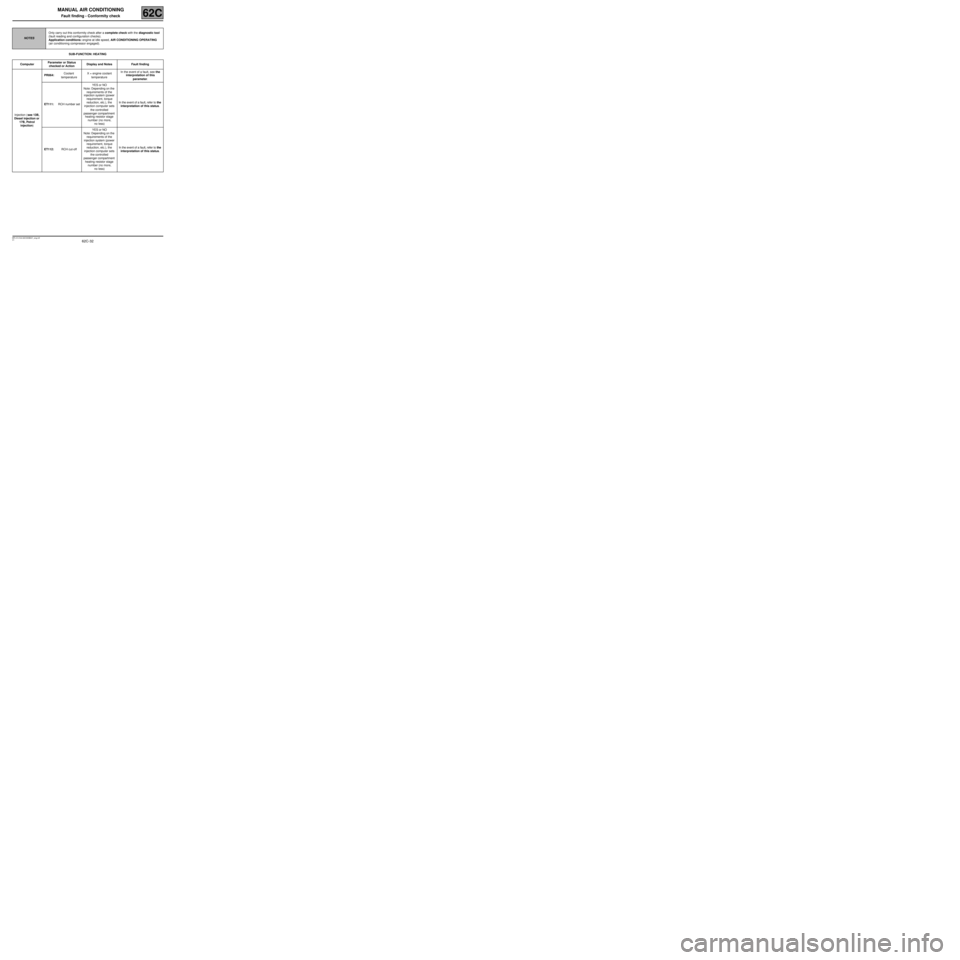
62C-32
MR-413-X44-62C000$637_eng.mif
V1
MANUAL AIR CONDITIONING
Fault finding - Conformity check62C
SUB-FUNCTION: HEATING
NOTESOnly carry out this conformity check after a complete check with the diagnostic tool
(fault reading and configuration checks).
Application conditions: engine at idle speed, AIR CONDITIONING OPERATING
(air conditioning compressor engaged).
ComputerParameter or Status
checked or ActionDisplay and Notes Fault finding
Injection (see 13B,
Diesel injection or
17B, Petrol
injection)PR064:Coolant
temperatureX = engine coolant
temperatureIn the event of a fault, see the
interpretation of this
parameter.
ET111:RCH number setYES or NO
Note: Depending on the
requirements of the
injection system (power
requirement, torque
reduction, etc.), the
injection computer sets
the controlled
passenger compartment
heating resistor stage
number (no more,
no less)In the event of a fault, refer to the
interpretation of this status.
ET112:RCH cut-offYES or NO
Note: Depending on the
requirements of the
injection system (power
requirement, torque
reduction, etc.), the
injection computer sets
the controlled
passenger compartment
heating resistor stage
number (no more,
no less)In the event of a fault, refer to the
interpretation of this status.
Page 39 of 63
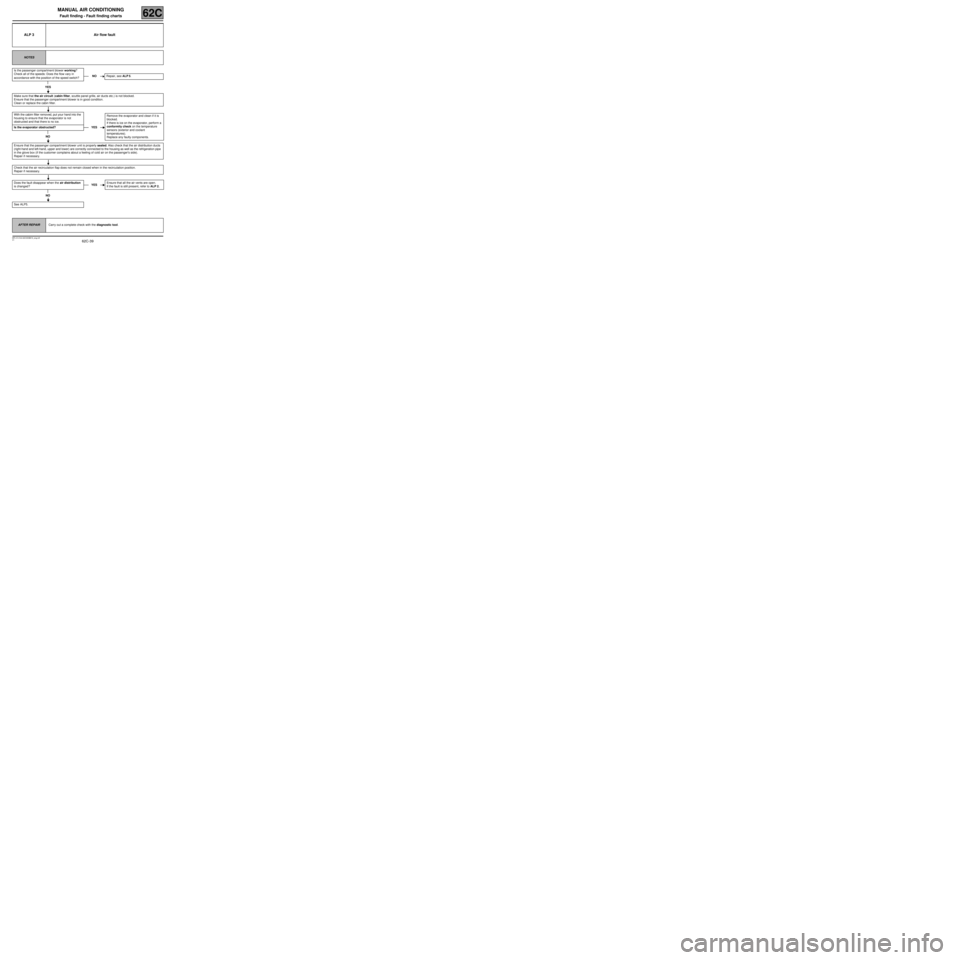
62C-39
MR-413-X44-62C000$819_eng.mif
V1
MANUAL AIR CONDITIONING
Fault finding - Fault finding charts62C
ALP 3 Air flow fault
NOTES
Is the passenger compartment blower working?
Check all of the speeds: Does the flow vary in
accordance with the position of the speed switch?
YES
Make sure that the air circuit (cabin filter, scuttle panel grille, air ducts etc.) is not blocked.
Ensure that the passenger compartment blower is in good condition.
Clean or replace the cabin filter.
With the cabim filter removed, put your hand into the
housing to ensure that the evaporator is not
obstructed and that there is no ice.
Is the evaporator obstructed?
NO
Ensure that the passenger compartment blower unit is properly sealed. Also check that the air distribution ducts
(right-hand and left-hand, upper and lower) are correctly connected to the housing as well as the refrigeration pipe
in the glove box (if the customer complains about a feeling of cold air on the passenger's side).
Repair if necessary.
Check that the air recirculation flap does not remain closed when in the recirculation position.
Repair if necessary.
Does the fault disappear when the air distribution
is changed ?
NO
See ALP5.
AFTER REPAIRCarry out a complete check with the diagnostic tool.
NORepair, see ALP 5.
YESRemove the evaporator and clean if it is
blocked.
If there is ice on the evaporator, perform a
conformity check on the temperature
sensors (exterior and coolant
temperatures).
Replace any faulty components.
YESEnsure that all the air vents are open.
If the fault is still present, refer to ALP 2.
Page 49 of 63
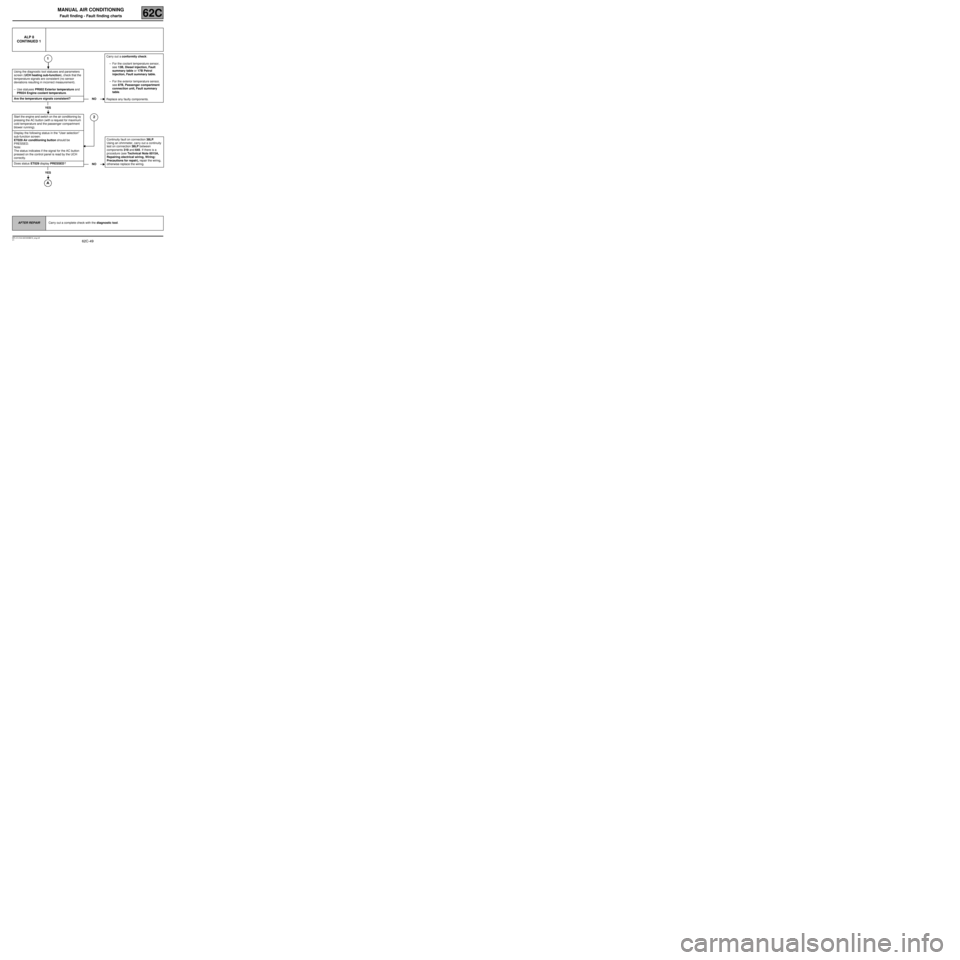
62C-49
MR-413-X44-62C000$819_eng.mif
V1
MANUAL AIR CONDITIONING
Fault finding - Fault finding charts62C
ALP 8
CONTINUED 1
1
Using the diagnostic tool statuses and parameters
screen (UCH heating sub-function), check that the
temperature signals are consistent (no sensor
deviations resulting in incorrect measurement).
–Use statuses PR002 Exterior temperature and
PR024 Engine coolant temperature.
Are the temperature signals consistent?
YES
Start the engine and switch on the air conditioning by
pressing the AC button (with a request for maximum
cold temperature and the passenger compartment
blower running).
2
Display the following status in the “User selection”
sub-function screen:
ET029 Air conditioning button should be
PRESSED.
Note:
The status indicates if the signal for the AC button
pressed on the control panel is read by the UCH
correctly.
Does status ET029 display PRESSED?
YES
NOCarry out a conformity check:
–For the coolant temperature sensor,
see 13B, Diesel injection, Fault
summary table or 17B Petrol
injection, Fault summary table.
–For the exterior temperature sensor,
see 87B, Passenger compartment
connection unit, Fault summary
table.
Replace any faulty components.
NOContinuity fault on connection 38LP.
Using an ohmmeter, carry out a continuity
test on connection 38LP between
components 319 and 645. If there is a
procedure (see Technical Note 6015A,
Repairing electrical wiring, Wiring:
Precautions for repair), repair the wiring,
otherwise replace the wiring.
AFTER REPAIRCarry out a complete check with the diagnostic tool.
Page 57 of 63
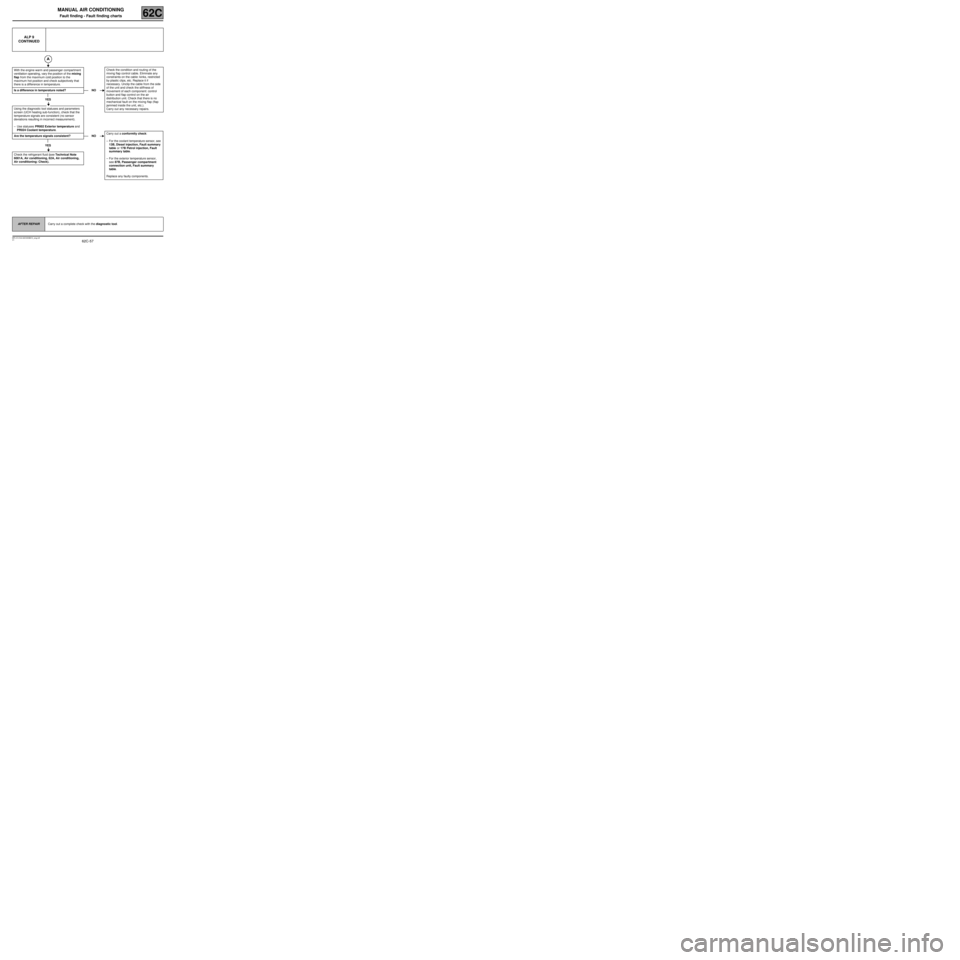
62C-57
MR-413-X44-62C000$910_eng.mif
V1
MANUAL AIR CONDITIONING
Fault finding - Fault finding charts62C
ALP 9
CONTINUED
With the engine warm and passenger compartment
ventilation operating, vary the position of the mixing
flap from the maximum cold position to the
maximum hot position and check subjectively that
there is a difference in temperature.
Is a difference in temperature noted?
YES
Using the diagnostic tool statuses and parameters
screen (UCH heating sub-function), check that the
temperature signals are consistent (no sensor
deviations resulting in incorrect measurement).
–Use statuses PR002 Exterior temperature and
PR024 Coolant temperature.
Are the temperature signals consistent?
YES
Check the refrigerant fluid (see Technical Note
6001A, Air conditioning, 62A, Air conditioning,
Air conditioning: Check).
NOCheck the condition and routing of the
mixing flap control cable. Eliminate any
constraints on the cable: kinks, restricted
by plastic clips, etc. Replace it if
necessary. Unclip the cable from the side
of the unit and check the stiffness of
movement of each component: control
button and flap control on the air
distribution unit. Check that there is no
mechanical fault on the mixing flap (flap
jammed inside the unit, etc.).
Carry out any necessary repairs.
NOCarry out a conformity check:
–For the coolant temperature sensor, see
13B, Diesel injection, Fault summary
table or 17B Petrol injection, Fault
summary table.
–For the exterior temperature sensor,
see 87B, Passenger compartment
connection unit, Fault summary
table.
Replace any faulty components.
AFTER REPAIRCarry out a complete check with the diagnostic tool.
Page 60 of 63
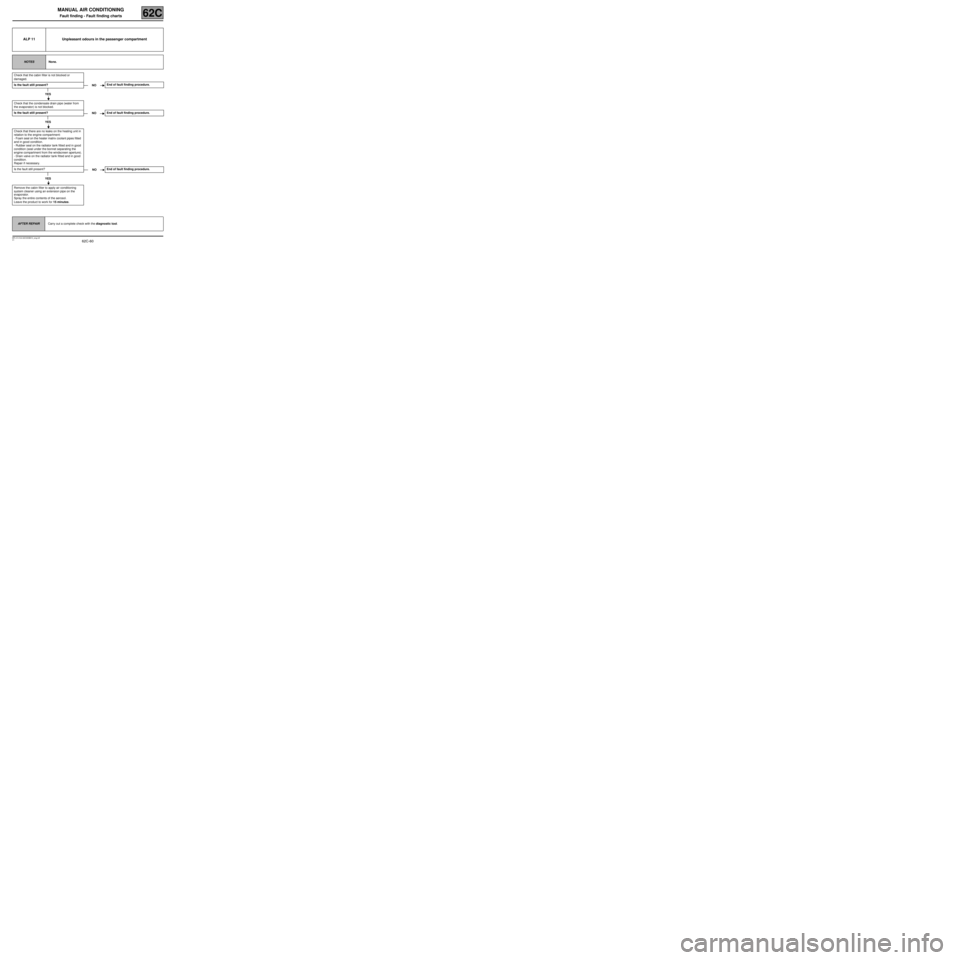
62C-60
MR-413-X44-62C000$910_eng.mif
V1
MANUAL AIR CONDITIONING
Fault finding - Fault finding charts62C
ALP 11 Unpleasant odours in the passenger compartment
NOTESNone.
Check that the cabin filter is not blocked or
damaged.
Is the fault still present?
YES
Check that the condensate drain pipe (water from
the evaporator) is not blocked.
Is the fault still present?
YES
Check that there are no leaks on the heating unit in
relation to the engine compartment:
- Foam seal on the heater matrix coolant pipes fitted
and in good condition.
- Rubber seal on the radiator tank fitted and in good
condition (seal under the bonnet separating the
engine compartment from the windscreen aperture).
- Drain valve on the radiator tank fitted and in good
condition.
Repair if necessary.
Is the fault still present?
YES
Remove the cabin filter to apply air conditioning
system cleaner using an extension pipe on the
evaporator.
Spray the entire contents of the aerosol.
Leave the product to work for 15 minutes.
NOEnd of fault finding procedure.
NOEnd of fault finding procedure.
NOEnd of fault finding procedure.
AFTER REPAIRCarry out a complete check with the diagnostic tool.
Page 61 of 63
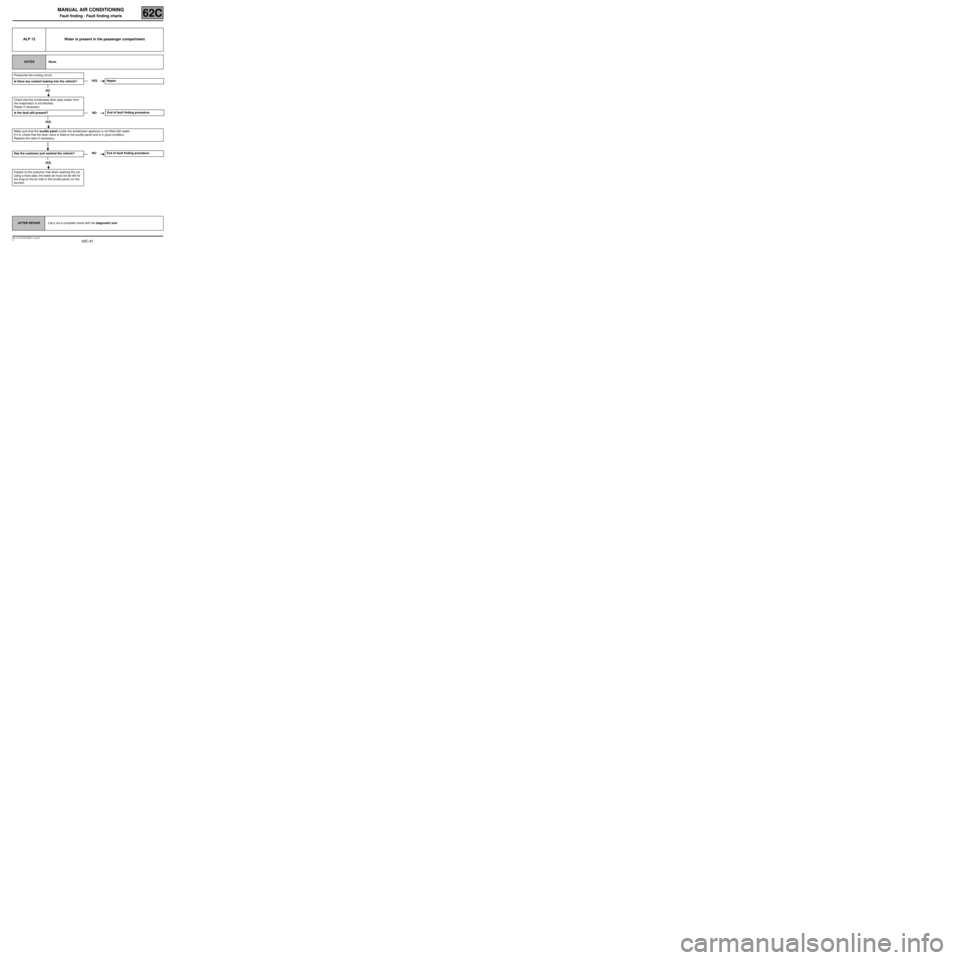
62C-61
MR-413-X44-62C000$910_eng.mif
V1
MANUAL AIR CONDITIONING
Fault finding - Fault finding charts62C
ALP 12 Water is present in the passenger compartment
NOTESNone.
Pressurise the cooling circuit.
Is there any coolant leaking into the vehicle?
NO
Check that the condensate drain pipe (water from
the evaporator) is not blocked.
Repair if necessary.
Is the fault still present?
YES
Make sure that the scuttle panel (under the windscreen aperture) is not filled with water.
If it is, check that the drain valve is fitted to the scuttle panel and is in good condition.
Replace the valve if necessary.
Has the customer just washed the vehicle?
YES
Explain to the customer that when washing the car
using a hose pipe, the water jet must not be left for
too long on the air inlet in the scuttle panel (on the
bonnet).
YES Repair.
NOEnd of fault finding procedure.
NO End of fault finding procedure.
AFTER REPAIRCarry out a complete check with the diagnostic tool.